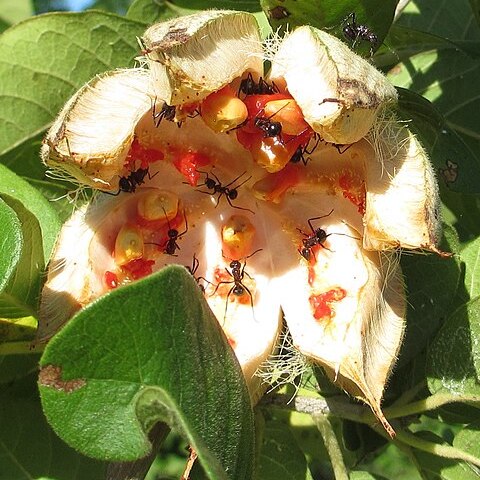A shrub or small tree. It grows 5 m tall. The young branches have a yellow covering with long hairs. The leaves appear just before the flowers. The leaf blade is 2-10 cm long by 1-7 cm wide. They are oval and rounded at the tip. The edges can be wavy. The flowers usually occur singly. They are in the axils of leaves or at the ends of branches. There are 7-12 petals and they are white. The fruit is woody and half round. It can have several long ridges along it. There are any seeds. They are narrowly oval and pale brown. They are in a thin red pulp. There are some varieties.
Leaves appearing just before the flowers; lamina 1.5–10 x 0.8–7.5 cm., obovate or obovate-oblong, apex rounded, base rounded or subcordate, margin entire or undulate, quite glabrous or sparsely or densely pilose on both sides, lateral nerves in 4–8 pairs, prominent below, looping within the margin, venation reticulate and sub-prominent below; petiole up to 1.5 cm. long or rarely up to 3 cm. long on old leaves.
Flowers usually solitary but occasionally in 1–3-flowered cymes in the leaf-axils or terminal on the branchlets; peduncle short, glabrous to densely pubescent; pedicels similar, up to 3.5 cm. long with deltoid, caducous, pubescent bracts at the base c. 2 mm. long.
Fruit woody, subglobose or ovoid, smooth or with c. 14 longitudinal ridges, glabrous or pubescent, splitting into c. 8 longitudinal segments, style-base persisting as a woody point.
Sepals 3 (4), 2 x 1.5–2 cm., rotund to orbicular, rounded at the apex, margins membranous, from glabrous to densely pubescent outside but always with some resinous glands.
Ovary urceolate, ± densely pilose, smooth or longitudinally sulcate; style up to 1 cm. long, columnar, pilose below, stigmas recurved, up to 2 mm. long.
Shrub or small tree up to c. 5 m. tall, young branches densely yellowish-pilose with rather long hairs, puberulous with short hairs, or glabrous.
Petals 7–12, white, up to 4.5 x 2.4 cm., narrowly obovate, rounded at the apex, cuneate to a shortly clawed base, glabrous.
Seeds many, ellipsoid, pale brown or buff, smooth or rugose, embedded in a thin scarlet pulp.
Stamens very numerous on glabrous filaments up to 10 mm. long; anthers c. 6 mm. long, linear.


